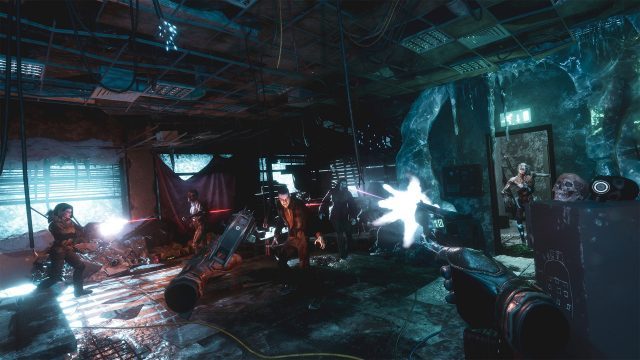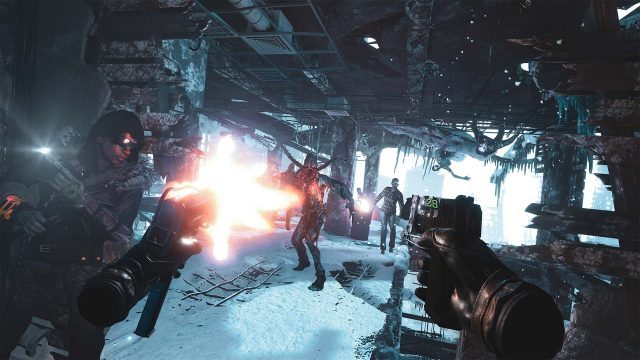After the Fall is an upcoming co-op VR zombie shooter that promises to let groups of up to four players battle for survival within a zombie infested landscape. Revealed last week at E3 2019, the game’s first demo offered visual polish underscored by bland gameplay that isn’t playing to VR’s strengths.
Let’s say this up front: After the Fall was only just revealed last week, and the game isn’t due out until sometime in 2020, so it’s likely to see big changes between now and then. It’s also worth noting that in the demo I played at the Oculus booth last week I was only playing with one other player, and the demo didn’t show any of the “seamless multiplayer” that developer Vertigo Games says will be a cornerstone of the game. That said, based on my experience with the demo, I’m hoping to see some significant changes to the core game design that better plays to VR’s strengths.
Great VR experiences are all about immersion—a sense of being in the world, not just seeing it and hearing it. But that doesn’t happen just because a player is wearing a headset—it’s the means of interacting with the virtual world that creates the kind of immersion that only VR is capable of. In this regard, After the Fall is doing a lot wrong right out of the gate for immersion; it seems distracted with delivering high-level non-VR gameplay tropes of loot shooters like Borderlands and The Division.


For one, guns ‘stick’ to your hands as soon a you grab one. As far as I could tell, the demo offered me no way to drop or holster a gun; once I grabbed a pistol, it simply became an extra appendage. When I wanted to reach out to grab items in the environment, my gun was still attached to my hand even though I wanted to pick something up with that hand—even so, the game allowed me to grab the thing I was reaching for by simply making the gun appear in the opposite hand when I hit the ‘grab’ button; when I released the object, the gun re-appeared back in my other hand. This is not only not intuitive, it’s also immersion-breaking.
But that’s fine anyway, because 90% of the generic loot I picked up from the environment (which will be used later as crafting currency for upgrades, etc) just magically flies toward your body after you press the grab button, and when it reaches you it vanishes into an invisible and apparently infinite inventory void. So now we’ve got two different systems for ‘grabbing’ items, some are hands-on (if oddly designed), while the rest is more of a magnetic net where certain objects just disappear into you.
Now, don’t get me wrong, ‘force-grab’ (pulling objects to you from afar) can often be a smart design choice for a VR game so that players don’t need to reach down to pick up objects that fall to the ground. But in After the Fall, force-grab is used not just as a convenience, but as an essential element to not pulling your hair out from the heaps and heaps of loot you’re expected to hoover up into your invisible inventory space. Over the course of just the demo alone, I must have picked up at least 100 individual pieces of loot, and it seems that the game will expect players to pick up thousands more as they grind for gear and unlocks.
After the Fall treats items like icons or points instead of physical objects that manifest in a virtual world, and it lacks embodiment because of it. It would likely be much more immersive to make loot more valuable and less frequent; instead of picking up hundreds of loot items throughout a level, maybe instead you’d open a few chests or boxes (hopefully with satisfying, hands-on interactions, not point and click) which would contain big caches of the loot at once.
Weapons are similarly symbolic in After the Fall instead of feeling physical and interactive in the way that VR does so well. While many VR games offer an intuitive reloading mechanism where (at a minimum) the player puts a new magazine into the weapon, After the Fall’s weapons reload automatically after the bullets run out… by magic, I guess. This means that while you’re spamming your pistol at groups of incoming zombies, at some point you’ll wait a few seconds while your gun decides to automatically reload itself as your character shouts “reloading!” and then you can start shooting again—all the while your arm is outstretched in a shooting pose just waiting to resume the action.
This ‘automatic magic reload when the bullets run out’ is jarring and doesn’t encourage the player to manage the state of their weapon, which contributes to the blandness of the shooting gameplay (which I’ll talk more about shortly). It’s possible to manually reload with a button press, but again, just pressing a button and watching the gun do its thing by magic feels very anti-immersion, especially considering this is not explained away by context (ie: these are contemporary weapons with bullets & magazines, not sci-fi or anything like that where automatic reloading would make sense).
On the ‘painfully missed opportunity’ front, I was traversing through a decrepit building of the post-apocalyptic variety and came across a series of cables dangling from the ceiling right near my head. As I naturally went to see if I could push one of the cables out of my way with the barrel of my pistol, I watched as it clipped perfectly through the gun. A tiny little bit of physics here would have made a simple but delightfully embodying moment, but instead the reality of this world was revealed to be paper thin in an instant. The better choice—if not some physics for the cable—would be to simply not put things that look like they can be touched, pushed, or grabbed, within reach of the player.
So, interactions aside, this is a zombie shooter. The game’s basic zombies are of the medium speed variety and most go down with one shot to the head. The game throws reasonably large groups of zombies at you, maybe 20 or so at a time. But without even the baseline of VR weapon interactions (like manual reloading), it’s really just a point and click affair. By the time I killed my 20th zombie, I may as well have killed them all—with copious ammo and a gun in each hand, there’s just zero sense of threat or joy in taking down one zombie after another after another by putting one bullet in each head. Even after finding this odd miniature-hand-mounted-zombie-seeking-missile-launcher weapon—which could lock on to five or so zombies at once before launching a salvo of mini-explosives—I wasn’t having any more fun killing these bland enemies.
Beyond the basic zombies I was introduced to, there was one other zombie type in the demo which was the ‘vomit’ variety that could spray you from a distance. Again though, fighting these guys was uninteresting at best—just shuffle around a bit to dodge the vomit while you keep holding your arms in their direction and pulling your triggers until they go bye-bye. Again—and I’m just riffing here—how interesting might it be if instead they spat some sticky goop that would lock you in place and prevent you from moving such that you had to physically dodge their vomit with your real body until you can dispatch them? This would make them a much more interesting threat and present an opportunity for some gameplay that feels truly native to VR.
The boss at the end of the demo was a big snowy zombie monster which formed the basis of an encounter that seemed poorly directed. Lots of the basic zombies were shuffling in from all directions while the faster boss zombie could close distance quickly by leaping in my direction. When it got in close it did a ground-pound attack and got its hand stuck in the ground opening up an opportunity to shoot a weak spot for a few seconds, otherwise it was a bullet-sponge affair. Battling this boss was really just a matter of moving around with a stick while holding my arms out and constantly pulling the trigger, allowing my guns to reload automatically, and continuing to shoot. Keeping the basic zombies at bay throughout might have made this more interesting if the mini missile launcher didn’t make them so easy to dispatch.
After the Fall has a long way to go if the developers want to deliver gameplay that feels native to VR, and I hope they do. The only thing the game really seems to have going for it is some pretty darn good visuals (a big upgrade from the studio’s previous title, Arizona Sunshine). Right now it almost feels like Vertigo Games is designing After the Fall to work on flat screens too—maybe they have ambitions to release a non-VR version of the game? Being overtly distracted with high-level non-VR game design goals that evoke the non-VR loot shooters is a sure-fire way to end up with a VR game that feels like a port, and Borderlands 2 VR already has that covered.

